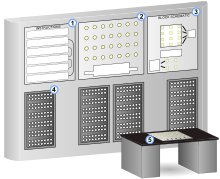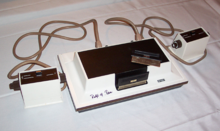First video game: Difference between revisions
Escape Orbit (talk | contribs) |
No edit summary |
||
| Line 46: | Line 46: | ||
*[http://spacewar.oversigma.com/ Spacewar! Java Emulation] |
*[http://spacewar.oversigma.com/ Spacewar! Java Emulation] |
||
*[http://www.gamersquarter.com/tennisfortwo/ Tennis for Two Simulation] |
*[http://www.gamersquarter.com/tennisfortwo/ Tennis for Two Simulation] |
||
==See also== |
|||
*[[History of video game consoles (first generation)]] |
|||
*[[History of video game companies]] |
|||
[[Category:Tennis video games]] |
|||
[[Category:Electronics companies]] |
|||
[[Category:First-generation video game consoles]] |
|||
[[Category:History of video games]] |
|||
[[Category:Monochrome video game consoles]] |
|||
[[Category:United States Department of Energy]] |
|||
Revision as of 15:46, 11 September 2008
There are numerous debates over who created the first video game, with the answer depending largely on how video games are defined. The evolution of video games represents a tangled web of several different industries, including scientific, computer, arcade, and consumer electronics.
Definition and usage of terms
The "video" in "video game" traditionally refers to a raster display device.[1] However, with the popular catch phrase use of the term "video game", the term now implies all display types, formats, and platforms.
Historians have also sought to bypass the issue by instead using the more inclusive "digital games" descriptive.[2] However, this term still leaves out the earlier analog-based computer games.
History

The earliest known interactive electronic game was created by Thomas T. Goldsmith Jr. and Estle Ray Mann on a cathode ray tube[3] in 1947. The game was a missile simulator inspired by radar displays from World War II. It used analog circuitry, not digital, to control the CRT beam and position a dot on the screen. Screen overlays were used for targets since graphics could not be drawn at the time.[1]
On May 5, 1951, the NIMROD computer was presented at the Festival of Britain. Using a panel of lights for its display, it was designed exclusively to play the game of NIM; this was the first instance of a digital computer designed specifically to play a game.[4] NIMROD could play either the traditional or "reverse" form of the game.
In 1952, Alexander S. Douglas made the first computer game to use a digital graphical display, OXO (Noughts and Crosses), for the EDSAC computer.
In 1958, William Higinbotham made an interactive game named Tennis for Two for the Brookhaven National Laboratory's annual visitor's day. This display, funded by the U.S. Department of Energy, was meant to promote atomic power, and used an analog computer and the vector display system of an oscilloscope.[5][6]
In 1961, MIT students Martin Graetz, Steve Russell, and Wayne Wiitanen created the game Spacewar! on a DEC PDP-1 computer which also used a vector display system.[1][6]

In 1966, Ralph Baer resumed work on an initial idea he had in 1951 to make an interactive game on a television set. In May of 1967, Baer and an associate created the first video game to use a raster-scan display, which was also the first video game to be played on a regular television set.[7] The Brown Box, the last prototype of seven, was released in May 1972 by Magnavox under the name Odyssey. It was the first home video game console.[1]
In 1971, Bill Pitts and Hugh Tuck developed the first coin-operated computer game, Galaxy Game, at Stanford University using a DEC PDP-11/20 computer; only one unit was ever built (although it was later adapted to run up to eight games at once). Two months after its installation, Computer Space by Nolan Bushnell and Ted Dabney was released, which was the first coin-operated video game to be commercially sold (and the first widely available video game of any kind, predating the Odyssey by six months). Both games were variations on the vector display 1961 Spacewar!; however, Bushnell and Dabney's used an actual video display by having an actual television set in the cabinet. Pong, also by Bushnell and Dabney, was not released until 1972 - a year after Computer Space, and also using the same television set design as Computer Space.
Baer was involved in court battles over patents that spanned the 1970s and 1980s. These trials defined a video game as an apparatus that displays games by manipulating the video display signal of the raster equipment: a television set, a monitor, etc. The previous computer games did not use a video display, so did not qualify as such in the courts.[1]
On February 13, 2006 Baer was given a National Medal of Technology by President George W. Bush in honor of his "groundbreaking and pioneering creation, development and commercialization of interactive video games."[8]
Notes and references
- ^ a b c d e Pong Story: Main Page
- ^ The Game Innovation Database
- ^ http://www.pong-story.com/2455992.pdf U.S. Patent #2,455,992
- ^ Nimrod Game Computer
- ^ http://www.bnl.gov/bnlweb/history/higinbotham.asp Brookhaven History: The First Video Game
- ^ a b Rabin, Steve. Introduction to Game Development. Massachusetts: Charles River Media, 2005.
- ^ Videogames Turn 40
- ^ President George W. Bush Presents...
External links
- Research
- Ralph H. Baer Papers, 1943-1953, 1966-1972, 2006 - Ralph Baer's prototypes and documentation housed at the Smithsonian Lemelson Center.
- pong-story.com
- Classic Gaming Expo 2000: Baer Describes the Birth of Videogames
- Videogames Turn 40 at 1UP.com.
- Game emulation
